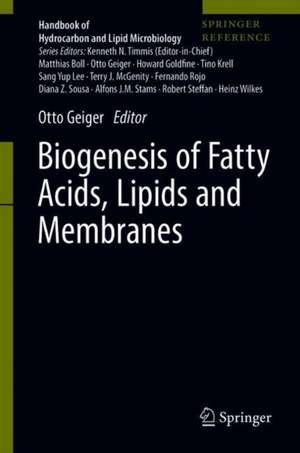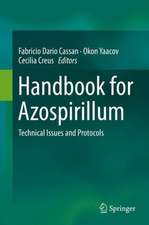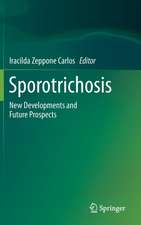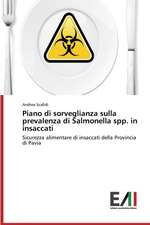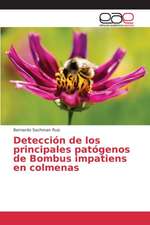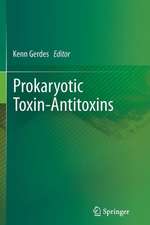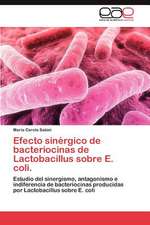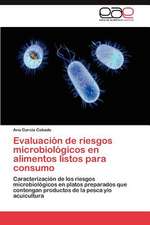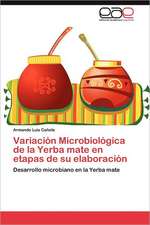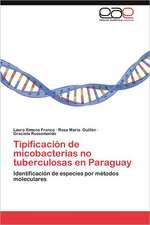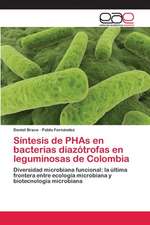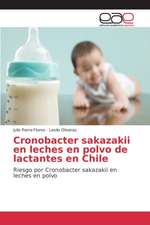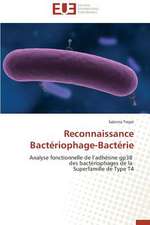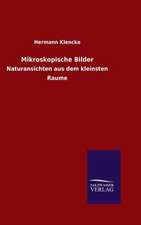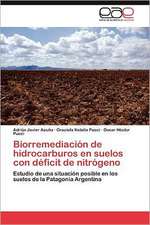Biogenesis of Fatty Acids, Lipids and Membranes: Handbook of Hydrocarbon and Lipid Microbiology
Editat de Otto Geigeren Limba Engleză Hardback – 29 ian 2019
All cells are delimited by a lipid membrane, which provides a crucial boundary in any known form of life. Readers will discover significant chapters on microbial lipid-carrying biomolecules and lipid/membrane-associated structures and processes.
Preț: 2384.25 lei
Preț vechi: 3137.17 lei
-24% Nou
Puncte Express: 3576
Preț estimativ în valută:
456.23€ • 477.54$ • 379.72£
456.23€ • 477.54$ • 379.72£
Carte tipărită la comandă
Livrare economică 26 martie-01 aprilie
Preluare comenzi: 021 569.72.76
Specificații
ISBN-13: 9783319504292
ISBN-10: 3319504290
Pagini: 850
Ilustrații: XXV, 886 p. 161 illus., 115 illus. in color.
Dimensiuni: 155 x 235 mm
Greutate: 1.91 kg
Ediția:1st ed. 2019
Editura: Springer International Publishing
Colecția Springer
Seria Handbook of Hydrocarbon and Lipid Microbiology
Locul publicării:Cham, Switzerland
ISBN-10: 3319504290
Pagini: 850
Ilustrații: XXV, 886 p. 161 illus., 115 illus. in color.
Dimensiuni: 155 x 235 mm
Greutate: 1.91 kg
Ediția:1st ed. 2019
Editura: Springer International Publishing
Colecția Springer
Seria Handbook of Hydrocarbon and Lipid Microbiology
Locul publicării:Cham, Switzerland
Cuprins
AcetylCoA Synthesis and Regulation.- AcetylCoA Synthesis and Role in Bacteria.- Autophagy in Stationary Phase of Growth.- Bacterial Sphingolipids.- Cell-contact-dependent Outer Membrane Exchange in Myxobacteria.- Contributions of Membrane Lipids to Bacterial Cell Homeostasis Upon Osmotic Challenge.- Dynamic Membrane Structure: Function Analysis by Means of Chemical Probes.- Evolution of Hydrophobic Storage Polymers.- Evolution of Lipids.- Evolution of Membranes.- Fatty Acid Synthesis and Regulation.- Fatty Acids: Introduction.- Formation of Bacterial Glycerol-based Membrane Lipids: Pathways, Enzymes, Reactions.- Formation of Fatty Acids.- Formation of Hopanoids.- Formation of Isoprenoids.- Formation of Lipochitin Oligosaccharide Signaling Molecules.- Functional Roles of Individual Membrane Lipids in Bacteria, Archaea and Eukaryotic Microbes.- Functional Roles of Non-membrane Lipids in Bacterial Signaling.- Hopanoids and Membrane Integrity and pH Homeostasis.- Lipid A.- Lipid Chaperones.- Lipid Chaperones and Regulation.- Lipid Intermediates in Bacterial Peptidoglycan Biosynthesis.- Lipid Metabolism in Microalgae.- Lipid Rafts.- Lipid-protein Interactions.- Lipid-protein Interactions Determining Membrane Fluidity in Prokaryotes and Eukaryotes.- Lipids as Receptors.- Lipoteichoic Acid Synthesis and Function in Gram-positive Bacteria.- Membrane Disrupting Proteins.- Membrane Formation and Regulation.- Membrane Homeostasis Upon Nutrient (C, N, P) Limitation.- Membrane Homeostasis upon pH Challenge.- Membrane Lipid Biogenesis.- Membrane Structure:Function Analysis by Means of Chemical Probes.- Membrane Structure:Function Analysis Through Reconstitution In Vitro.- Membrane Vesicles, Nanopods and Nanotubes of Archaea.- Metabolism and Regulation of Glycerolipids in Yeast.- Metabolism and Roles of Sphingolipids in Yeast Saccharamyces cerevisiae.- Modeling Lipid Membranes.- Modeling Lipid Metabolism in Yeast.- Mycolic Acids: Structures, Biosynthesis , and Function.- NonpolarLipids in Yeast: Synthesis, Storage and Degradation.- Ornithine Lipids and Other Amino Acid-containing Acyloxyacyl Lipids.- Outer Membrane Extension Nanowires of Bacteria.- Outer Membrane Vesicles of Bacteria.- Phenolic Lipids Synthesized by Type III Polyketide Synthases.- Players in the Nonpolar Lipid Game - Proteins Involved in Nonpolar Lipid Metabolism in Yeast.- Polyhydroxyalkanoate Biogenesis.- Preface: Biogenesis of Fatty Acids, Lipids and Membranes.- Production of Wax Esters by Bacteria.- Protein Lipidation, Elucidation by Chemical Proteomics, and its Functional Roles.- Regulation of Membrane Lipid Homeostasis in Bacteria upon Temperature Change.- Role of Lipid Domains in Bacterial Cell Processes.- Role of Lipids in the Eukaryotic Secretory Pathway.- Role of the BAM Complex in Outer Membrane Assembly.- Structure:Function of Transmembrane Domains of Proteins and Transmembrane Organelles.- Synthesis of AcetylCoA from Carbon Dioxide in Acetogenic Bacteria.- Synthesis of Acetyl-CoAfrom Carbon Dioxide in Acetogenic Bacteria.- The Biosynthesis and Evolution of Archaeal Membranes and Ether Phospholipids.- Type III Polyketide Synthases Responsible for Phenolic Lipid Synthesis.- Vitamin Formation from Fatty Acid Precursors.- Wax Ester and Triacylglycerol Biosynthesis in Bacteria.
Notă biografică
Otto Geiger studied biology at the University of Hohenheim in Stuttgart, Germany and after investigating “Quinoproteins and their prosthetic group pyrroloquinoline quinone” at the Institute of Microbiology, he received his doctoral title from the same institution in 1987. As a Feodor-Lynen Fellow of the Alexander von Humboldt Foundation, he did postdoctoral work in the United States at Harvard Medical School with Eugene P. Kennedy on the biosynthesis and function of periplasmic glucans in Gram-negative bacteria. Subsequently, together with Ben Lugtenberg and Herman Spaink, he investigated the biosynthesis of lipochitin oligosaccharide signals that cause nodule formation on legume host plants at the Institute of Molecular Plant Sciences, Leiden University in the Netherlands. From 1993 to 1999 he was a Research Group Leader in the Department of Biotechnology at the Technical University of Berlin, where he habilitated for Biochemistry in 1997. Otto Geiger was an InternationalResearch Scholar (2002–2006) of the Howard Hughes Medical Institute. He currently holds the position of Professor (Investigador Titular C) at the Center for Genomic Sciences (formerly the Research Center for Nitrogen Fixation) at the National Autonomous University of Mexico (Cuernavaca) which he joined in 1999. Geiger’s group discovered the phosphatidylcholine synthase pathway which constitutes a major route for phosphatidylcholine (lecithin) formation in bacteria as well as the biosynthesis pathway for ornithine-containing lipids which are widespread bioactive lipids encountered in bacterial membranes. More recently, he discovered molecular mechanisms for lipid remodeling of bacterial membranes in response to different types of stress. Presently, he studies the molecular functions of phosphatidylcholine in bacteria as well as the biosynthesis, transport, and function of sphingolipids in bacteria. He functions as an Editor for the journal BMC Microbiology and for the Handbook of Hydrocarbon and Lipid Microbiology.
Caracteristici
Provides an extensive overview on how lipids are formed, assembled, and engaged to generate biological membranes Chapters are written in an informative style, are well illustrated and interesting to read for the newcomer as well as the senior scientist in the field Functional aspects of lipids, lipid residues and membranes in microbes are elaborated in detail Biosynthesis pathways for the different microbial lipid classes provide a unique compendium of lipid biology in the living world Readers obtain a profound understanding of lipid and membrane formation, function and remodeling Includes supplementary material: sn.pub/extras
